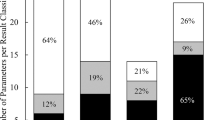Abstract
Riparian buffer restorations are used as management tools to produce favorable water quality impacts, moreover among the many benefits riparian buffers may provide, their application as instruments for water quality restoration rests on a relatively firm foundation of research. However, the extent to which buffers can restore riparian ecosystems; their functionality and species composition, are essentially unknown. In light of the foregoing, two broad areas of research are indicated. First, data are needed to document the relative effectiveness of riparian buffers that differ according to width, length, and plant species composition. These questions, of managing buffer dimension and species composition for functionality, are of central importance even when attenuation of nutrient and sediment loads alone are considered. Second, where ecosystem restoration is the goal, effects to in-stream and terrestrial riparian biota need to be considered. Relatedly, the effects of the restoration on the landscape need to be considered. Particularly, at what rate do the effects of the riparian buffer on in-stream water quality, biota, and habitat diminish downstream from restored sites? Answers to these important questions are needed, for streams and watersheds of different size and for areas of differing soil type within watersheds. U.S. EPA-NRMRL has initiated as research project that will document the potential for buffers to restore riparian ecosystems; focusing on water quality effects, but also, importantly, documenting effects on biota. While substantial riparian buffer management initiatives are already underway, the extent of landscapes that influence riparian ecosystems in the eastern United States is large; leaving ample opportunity for this suggested research to provide improved buffer designs in the future. The ultimate goal of research projects developed under this paradigm of ecosystem restoration is to develop data that are needed to implement riparian buffer restorations in the mid-Atlantic and elsewhere, especially the eastern United States.
Similar content being viewed by others
References
Ator, S.W. and Ferrari, M.J.: 1997, Nitrate and selected pesticides in ground water of the mid-Atlantic region, USGA Water-Resources Investigations Report 97-4139.
Baker, L.A.: 1992, ‘Introduction to nonpoint source pollution in the United States and prospects for wetland use,’ Ecological Engineering 1, 1-26.
Bertulli, J.A.: 1981, ‘Influence of a forested wetland on a southern Ontario watershed’, in: Proceedings of the Ontario wetlands conference, A. Champagne, (ed.), Federation of Ontario Naturalists and dept. of Applied Geography, Ryerson Polytechnical Inst., Toronto, Ontario, pp. 33-471.
Bren, L.L.: 1993, ‘Riparian zone, stream, and floodplain issues: a review’, J. Hydrol 150, 277-299.
Castelle, A.J., Conolly, C., Emers, M., Metz, E.D., Meyer, S., Witter, M., Mauermann, S., Erickson, T. and Cooke, S.S.: 1992, Wetland buffers: use and effectiveness, Publication 92-10, Adolfson Assoc., for Shorelands and Coastal Zone Management. Program, Washington Dept. of Ecology, Olympia, WA.
Castelle, A.J., Johnson, A.W. and Conolly, C.: 1994, ‘Wetland and stream buffer size requirements; a review’, Journal of Environmental Quality 23, 878-882.
Chaillou, J.C., Weisberg, S.B., Kutz, F.W., DeMoss, T.E., Mangiaracina, L., Magnien, R., Eskin, R., Maxted, J., Price, K. and Summers, J.K.: 1996, Assessment of the ecological condition of the Delaware and Maryland coastal bays, USEPA Office of Research and Development, Washington, DC 20460, USEPA/620-R-96/004.
Cheasapeake Bay Program Executive Council: 1987, 1987 Chesapeake Bay agreement, Chesapeake Bay Program Office, Annapolis, MD.
____: 1992, Chesapeake Bay agreement: 1992 amendments, Chesapeake Bay Program Office, Annapolis, MD.
____: 1997, Baywide nutrient reduction progress and future direction, Directive No. 97-1, Chesapeake Bay Program Office, Annapolis, MD.
Federal Interagency Stream Restoration Working Group: 1998, Stream corridor restoration; principles, processes, and practices.
Groffman, P.M., Gold, A.J., Husband, T.P., Simmons, R.C. and Eddleman, W.R.: 1990, Final report; Narragansett Bay project; an investigation into multiple uses of vegetated buffer strips. University of Rhode Island, Kingston.
Lowrance, R., Leonard, R. and Sheridan, J.: 1985, ‘Managing riparian ecosystems to control nonpoint pollution’, Journal of Soil and Water Conservation 40, 87-91.
Jones, K.B., Riitters, K.H., Wickham, J.D., Tankersley, Jr., R.D., O'Neill, R.V., Chaloud, D.J., Smith, E.R. and Neale, A.C.: 1997, An ecological assessment of the United States mid-Atlantic region, USEPA, Office of Research and Development, EPA/600/R-97/130.
Jorgensen, E.E., Geron, C. and Sewell, G.W.: 1997, Risk management research plan for ecosystem restoration in watersheds, EPA/600/R-97/078, United States Environmental Protection Agency.
National Association of Conservation Districts: 1994, Riparian ecosystems in the humid U.S.: functions, values and management, Washington, DC.
National Research Council: 1992, Restoration of aquatic ecosystems, National Academy Press, Washington, DC 552pp.
Osborne, L.L. and Kovacic, D.A.: 1993, ‘Riparian vegetated buffer strips in water-quality restoration and stream management’, Freshwater Biology 29, 243-258.
Paul, J.F., C.J. Strobel, C.J., Melzian, B.D., Kiddon, J.A., Lattimer, J.S., Campbell, D.E. and Cobb, D.J.: 1998, ‘State of the estuaries in the mid-Atlantic region of the United States’, Environmental Monitoring and Assessment 51, 269-284.
Rodgers, Jr., J.H. and Dunn, A.: 1992, ‘Developing design guidelines for constructed wetlands to remove pesticides from agricultural runoff’, Ecological Engineering 1, 83-95.
Schultze, R.C., Colletti, J.P., Isenhart, T.M., Simpkins, W.W., Mize, C.W. and Thompson, M.L.: 1995, ‘Design and placement of a multi-species riparian buffer strip system’, Agroforestry Systems 29, 201-226.
Smith, R.A., Alexander, R.B. and Wolman, M.G.: 1987, ‘Water-quality trends in the nation's rivers’, Science 235, 1607-1615.
USDA: 1996, Engineering field handbook; Chapter 16, streambank and shoreline protection. NRCS.
USEPA: 1989, Nonpoint sources: agenda for the future, WH-556. US EPA, Office of Water, Washington, DC, 31pp.
USEPA: 1997, 1997 Update to ORD's strategic plan, EPA/600/R-97/015.
USEPA: 1998, Condition of the mid-Atlantic estuaries. USEPA Office of Research and Development, Washington, DC 20460, EPA 903-R-98-012.
van der Valk, A.G. and Jolly, R.W.: 1992, “Recommendations for research to develop guidelines for the use of wetlands to control rural nonpoint source pollution”, Ecological Engineering 1, 115-134.
Author information
Authors and Affiliations
Rights and permissions
About this article
Cite this article
Jorgensen, E.E., Canfield, T.J. & Kutz, F.W. Restored Riparian Buffers as Tools for Ecosystem Restoration in the MAIA; Processes, Endpoints, and Measures of Success for Water, Soil, Flora, and Fauna. Environ Monit Assess 63, 199–210 (2000). https://doi.org/10.1023/A:1006491702574
Issue Date:
DOI: https://doi.org/10.1023/A:1006491702574




